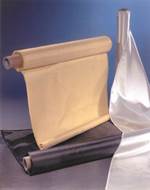Resins
Resins fall into two broad categories: thermoset and thermoplastic. While both resin types consist of molecular polymer chains, thermosets crosslink during the cure reaction (initiated by heat, catalysts or both) and “set” into a final rigid form. Thermoplastic molecular chains are processed at higher temperat
Resins fall into two broad categories: thermoset and thermoplastic. While both resin types consist of molecular polymer chains, thermosets crosslink during the cure reaction (initiated by heat, catalysts or both) and “set” into a final rigid form. Thermoplastic molecular chains are processed at higher temperatures and take the part shape upon cooling; they are capable of being reheated and reshaped more than once. However, because of their low viscosity, they pose significant issues when it comes to complete fiber wetout, which is critical in producing structural parts. Lower viscosity thermoset resins are more common in applications such as large structural beams, gratings, and decks. Thermoplastics, because of their toughness, flexibility and chemical inertness, are common in piping applications, such as spoolable tubulars and downhole parts.
Among thermosets, unsaturated polyester resins are the most common. They are relatively low in cost, easy to handle and produce a good balance of mechanical, electrical and chemical properties. Specific types of polyester are often referred to by certain formulation ingredients, such as orthopolyesters (with the molecular structure built upon orthophthalic acid) and isopolyester resins (which build upon isophthalic acid for superior chemical and thermal resistance). General-purpose polyesters are distinguished from specialty polyesters, which can be chemically tailored for characteristics such as flexibility, corrosion-resistance and heat/fire resistance.
Thermoset resins, typically selected for higher-performing structural or fire-resistant applications, include vinyl esters, epoxies and phenolics. Vinyl esters were developed to combine the advantages of epoxies with the easier handling and fast cure of polyesters. With their excellent corrosion and moisture resistance, they perform well in severe chemical environments. Epoxies are tough, with higher strength and stiffness and less shrinkage than polyesters. Their higher cost must be justified by the demands of the application, and their higher viscosity and postcure requirements make them more challenging to work with, although they are readily adaptable to most manufacturing processes. Highly heat resistant phenolics are useful as matrices in composite parts where smoke emission, combustion and toxicity requirements are critical, and are commonly specified for platform components such as gratings.
Thermoplastics are used in the manufacture of tough, impact-resistant offshore parts that must withstand hostile chemical environments. “Engineered” thermoplastics, such as polyphenylene sulfide (PPS), polyvinylidene fluoride (PVDF), polyetheretherketone (PEEK) and some formulations of nylon are distinguished from “commodity” thermoplastics like polypropylene and polyethylene by higher strength and performance.
Additives and fillers are used to customize resins to improve suitability for specific applications, such as better processability (e.g., reduction of viscosity), reduction of shrinkage, or improvement of properties such as toughness. Gypsum, bromine, alumina trihydrate and other fillers improve smoke and fire resistance, mechanical strength, chemical or water resistance.
Related Content
-
Formula 1 team adopts Roboze 3D printed composites
The Visa Cash App RB Formula 1 team is collaborating with Roboze to reduce weight and create parts with complex geometries via carbon fiber/PEEK.
-
Hitachi Rail chooses Roboze printers, materials including carbon fiber/PEEK for railway spare parts
The Roboze ARGO 500 will be used at Hitachi Rail factories in Naples, Italy and Maryland, U.S. to reduce cost and delivery times for prototypes and spare parts.
-
In oil and gas, an additive manufacturing standard (API 20T) will aid adoption of composites
Polymer AM equipment maker Roboze sees how the oil and gas industry’s way forward with additive is like that of another high-stakes industry, aerospace, and also different in important aspects.













